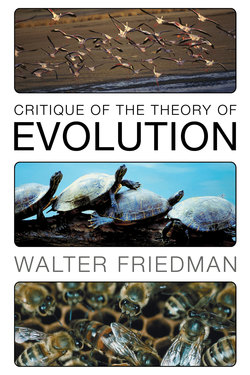Читать книгу Critique of the Theory of Evolution - Walter Friedman - Страница 11
На сайте Литреса книга снята с продажи.
6 : Mutations
ОглавлениеEvolutionists use advances in the science of genetics in attempts to justify the evolutionary theory. From the evolutionist’s point of view, the most important genetic concept is the concept of germinal mutations (unlike somatic mutations, germinal mutations are transmitted to the succeeding generations).
Germinal mutations could be divided into two categories: 1) Mutations that occur due to known external factors such as radiation, pesticides, herbicides, etc. These mutations occur on a large scale. These mutations are also called “non-random mutations”; the word non-random is used to indicate that the cause of a mutation is known. 2) Mutations that occur due to unknown internal factors—these mutations are caused by changes in cellular structure. These mutations are also called “random mutations”; the word random is used to indicate that the exact cause of a mutation is unknown. Two or more random mutations cannot occur at the same time because simultaneous occurrence would classify them as non-random mutations.
In an attempt to avoid the search for a cause of mutations that occurred millions of years ago, evolutionists take into consideration random mutations alone. This is a reasonable assumption from a logical standpoint; however, from a mathematical standpoint it causes enormous difficulties.
Evolutionists use the following explanation of how random mutations spread to the entire population:
Suppose a random mutation beneficial to an organism’s survival occurred in a single individual. Also assume that at least two of the descendants of a couple will receive new characteristics; this is a good assumption because a vast majority of the animals produce more than two cubs during their lifetimes. In a short period of time new characteristics will spread to the entire population at an exponentially increasing rate.
However, the evolutionists’ calculations are completely wrong because they do not take into account the rate of survival.
Denote by N the total number of members of a population, by q the average number of members that will reach the reproductive age, and by R the survival rate. Then R = q/N. Obviously, 0 < R < 1.
Denote by K the number of generations that will retain newly acquired characteristics that came as the result of a random mutation, by PK the probability that this characteristic will be found in the K-th generation. It can be proven that Pk = A × RK.
Here, A is a proportionality constant depending on the average number of cubs. (Readers with a basic knowledge of the probability theory could consult Appendix A.)
With each passing generation Pk goes rapidly down and after about 20 generations it is, for all practical purposes, equal to zero.
This is how the probability theory puts the evolutionary theory to shame. It is no wonder that the geneticists and mathematicians are among the most ardent opponents of Darwin’s theory.
There is another reason why geneticists are opposed to the evolutionary theory. It has something to do with the conclusions that contradict experimental genetic data.
Recently several groups of geneticists came to the conclusion that the human genotype could be traced to a woman who, probably, lived several thousand years ago somewhere in North Africa; they even dubbed her “Eve.” Not all geneticists agree with this conclusion, but even those who disagree do not state that such tracing is impossible in principle; they simply say that it is beyond the level of modern science, but that in the not-so-distant future it will become a reality. This tracing leads to three possibilities:
1) The human race has two progenitors, a man and a woman.
For the evolutionists, this opens a can of worms with all kinds of unsettling questions about religion.
2) The trail goes beyond the human race and stops with two pre-historic beings, say, male and female apes.
This raises another set of unsettling questions—why does the trail stop here? Who were these beings? Were they created by an extraterrestrial race? What is the meaning of this?
3) The genetic trail leads all the way back to the original cell.
This is a sign of even more trouble! For the original cell is a single parent whose existence implies that all living organisms on this planet carry its genetic imprint. By isolating a common denominator, the imprint of the original cell, in primitive organisms, geneticists should be able to determine how inorganic matter evolved into organic matter with a DNA-like structure that produced the original cell. However, as the research in the field of genetics shows, the imprint of the original cell is a fiction that has nothing to do with serious science. Evolutionists ventured into the field of genetics but came up empty-handed.
Now we are going to present the extremely important argument above in a nutshell, so the evolutionists can read it and weep!
In biology textbooks the DNA compounds are described as long strands of molecules bonded together; modern technology allows these long strands to be cut into smaller ones in an arbitrary manner. If the theories of the original cell, or original cells, are correct, it is possible to cut human DNA, or the DNA of any other species, into smaller and smaller strands in such a way that at least one strand will have a structure identical to that of an original cell. If this strand, also called the imprint of an original cell, is placed into a chemical solution containing enough building blocks, it will imitate the function of an original cell by duplicating itself. As all geneticists agree, such duplication has not been observed so far. A small number of geneticists contend that the imprint mutated beyond recognition and that the original structure is gone for good. However, a majority of the geneticists counter their argument by saying that such mutation would have destroyed the self-reproductive capability.
